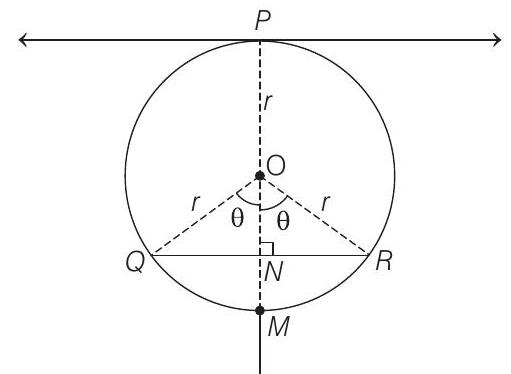Application Of Derivatives Ques 107
107. A point $P$ is given on the circumference of a circle of radius $r$. Chord $Q R$ is parallel to the tangent at $P$. Determine the maximum possible area of the $\triangle P Q R$.
$(1990,4 \mathrm{M})$
Show Answer
Answer:
Correct Answer: 107.$\frac{3 \sqrt{3}}{4} r^{2}$ sq. units
Solution:
Formula:
Maxima and Minima of functions of one variable :
- Since, the chord $Q R$ is parallel to the tangent at $P$.
$ \therefore \quad O N \perp Q R $
Consequently, $N$ is the mid-point of chord $Q R$.
$ \begin{aligned} & \therefore \quad Q R=2 Q N=2 r \sin \theta \\ & \text { Also, } \quad O N=r \cos \theta \\ & \therefore \quad P N=r+r \cos \theta \end{aligned} $

Let $A$ denotes the area of $\triangle P Q R$.
Then, $\quad A=\frac{1}{2} \cdot 2 r \sin \theta(r+r \cos \theta)$
$\Rightarrow \quad A=r^{2}(\sin \theta+\sin \theta \cos \theta)$
$\Rightarrow \quad A=r^{2}\left(\sin \theta+\frac{1}{2} \sin 2 \theta\right)$
$\Rightarrow \quad \frac{d A}{d \theta}=r^{2}(\cos \theta+\cos 2 \theta)$
and $\quad \frac{d^{2} A}{d \theta^{2}}=r^{2}(-\sin \theta-2 \sin 2 \theta)$
For maximum and minimum values of $\theta$, we put $\frac{d A}{d \theta}=0$
$\Rightarrow \cos \theta+\cos 2 \theta=0 \Rightarrow \cos 2 \theta=-\cos \theta$
$\Rightarrow \quad \cos \theta=\cos (\pi-2 \theta) \Rightarrow \theta=\frac{\pi}{3}$
Clearly, $\quad \frac{d^{2} A}{d \theta^{2}}<0 \quad$ for $\quad \theta=\frac{\pi}{3}$
Hence, the area of $\triangle P Q R$ is maximum when $\theta=\frac{\pi}{3}$.
The maximum area of $\triangle P Q R$ is given by
$ \begin{aligned} A=r^{2} & (\sin \frac{\pi}{3}+\frac{1}{2} \sin \frac{2 \pi}{3})=r^{2} (\frac{\sqrt{3}}{2}+\frac{\sqrt{3}}{4}) \\ & =\frac{3 \sqrt{3}}{4} r^{2} \text { sq units } \end{aligned} $





